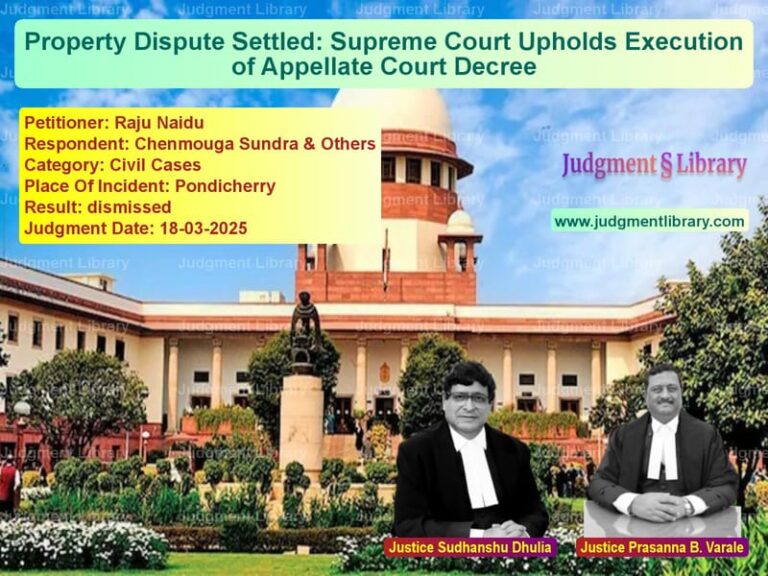Supreme Court Rules on Acquittal in Police Shooting Incident: Legal Precedents and Court’s Rationale
The Supreme Court of India recently ruled in the criminal appeal case Surendra Singh & Others v. State of Uttarakhand, where the appellants, four individuals including police constables and a driver, sought to overturn their conviction for the murder of Manisha Chauhan, which was initially handled by the trial court and the High Court. The case involved the death of Manisha Chauhan, a woman who was allegedly shot by the police when they attempted to stop a car carrying suspected smugglers. The Supreme Court’s judgment is crucial in understanding the scope of criminal liability, especially under Section 302 IPC (murder), in cases where the accused had not directly participated in the act but were accused under Section 34 IPC (common intention).
This case focuses on the legal implications of Section 34 of the Indian Penal Code, where criminal liability can extend to individuals who may not have directly committed the offense but were part of a collective criminal act. The appellants argued that the High Court erred in convicting them under Section 34 IPC, citing the lack of direct evidence connecting them to the crime. The Supreme Court’s judgment addressed the conflict between the trial court’s acquittal and the High Court’s conviction, ultimately quashing the convictions of the appellants.
Background of the Case
The incident leading to the case occurred on November 15, 2004, when a team of police officers, including the appellants, attempted to intercept a Maruti car suspected to be carrying illegal liquor. When the police signaled the car to stop, the driver allegedly refused to comply. Constable Jagdish Singh, one of the appellants, fired a shot from his service revolver, which hit Manisha Chauhan, who was sitting in the front seat of the car. She died shortly thereafter, and the police involved in the incident were later accused of causing her death.
The initial trial court’s decision acquitted the appellants, finding insufficient evidence to link them to the crime. The High Court, however, overturned this acquittal, convicting the appellants under Section 302 read with Section 34 IPC. The State of Uttarakhand had filed an appeal against the trial court’s acquittal of the appellants, and the matter eventually reached the Supreme Court.
Key Legal Issues
- Whether the appellants were correctly convicted under Section 302 read with Section 34 IPC despite their lack of direct involvement in the shooting.
- The applicability of Section 34 IPC in a case where the accused were present during the commission of a crime but did not directly participate in the criminal act.
- Whether the trial court’s acquittal of the appellants was justified based on the available evidence, and if the High Court’s decision to convict them was based on an incorrect interpretation of the law.
- The role of eyewitness testimonies and the adequacy of evidence in establishing criminal liability in cases involving police personnel.
Arguments of the Parties
Petitioner’s Arguments
The appellants, represented by Senior Counsel Mr. Devadatt Kamat, raised the following arguments:
- The trial court had rightly acquitted the appellants due to the lack of sufficient evidence to link them to the crime.
- The High Court’s conviction was based on a misunderstanding of the evidence and a misapplication of Section 34 IPC. The appellants were not involved in the direct act of shooting the deceased.
- Section 34 IPC could not be invoked unless it could be proven that the appellants had shared a common intention to commit the crime of murder.
- The eyewitnesses, including the complainant Sanjeev Chauhan (PW-1) and others, did not provide clear, corroborated evidence that the appellants had prior knowledge of or shared a common intention to kill the deceased.
Respondents’ Arguments
The respondents, represented by the State of Uttarakhand, countered with the following points:
- The appellants were all involved in the incident, and their presence in the car and their subsequent actions indicated a shared common intention to commit the crime under Section 34 IPC.
- The fact that the appellants were present during the shooting and had been part of the operation meant they were complicit in the crime, even if they did not directly shoot the victim.
- The High Court’s judgment was correct in convicting the appellants because it was based on a thorough evaluation of all the evidence, including the appellants’ admissions and the testimony of eyewitnesses.
- Under Section 34 IPC, the prosecution did not need to prove individual involvement in the act of murder. Instead, it was sufficient to prove that the crime was committed by the group in furtherance of their common intention.
Supreme Court’s Observations
The Supreme Court, after considering the arguments and reviewing the case, made the following observations:
“In cases where Section 34 IPC is invoked, it is essential to establish that the accused shared a common intention and participated in the crime collectively. Mere presence at the scene of the crime is not enough to invoke Section 34 unless it is proven that the crime was committed in furtherance of a common intention.”
The Court also noted that the trial court had rightly observed that the evidence presented was insufficient to connect the appellants to the crime beyond reasonable doubt. The Court emphasized that the conviction under Section 34 IPC must be based on clear, corroborated evidence that shows the accused had prior knowledge and a shared intention to commit the crime.
Final Judgment and Directions
The Supreme Court, after evaluating the evidence and legal principles, ruled as follows:
- The appeals filed by the appellants were allowed, and the judgment of the High Court convicting the appellants was quashed.
- The acquittal by the trial court was upheld, as the evidence presented did not meet the threshold required to prove the appellants’ involvement in the murder under Section 302 IPC.
- The Court emphasized that the prosecution had failed to establish that the appellants had shared a common intention to commit murder with the person who shot the deceased.
- The appellants were acquitted of all charges, and their convictions were overturned, leading to their release.
Implications of the Judgment
This judgment reinforces the principle that mere presence at the scene of a crime is not sufficient to convict an individual under Section 34 IPC. The Court clarified that for a conviction under Section 34 IPC, it must be demonstrated that the accused shared a common intention to commit the crime, and this intention must be established through credible and corroborated evidence. The ruling also emphasizes the need for careful judicial scrutiny of evidence in criminal cases, particularly when police personnel are involved.
Conclusion
The Supreme Court’s ruling in Surendra Singh & Others v. State of Uttarakhand serves as an important reminder of the high standards of evidence required to convict individuals under Section 34 IPC. The judgment underscores the importance of proving common intention and participation in a crime, not just the presence of the accused at the scene. It also highlights the Court’s role in ensuring that individuals are not wrongly convicted based on insufficient or unreliable evidence. This decision will have a lasting impact on how cases involving police personnel and complex criminal acts are handled in the future.
Petitioner Name: Surendra Singh & Others.Respondent Name: State of Uttarakhand.Judgment By: Justice B.R. Gavai, Justice Augustine George Masih.Place Of Incident: Uttarakhand.Judgment Date: 28-01-2025.
Don’t miss out on the full details! Download the complete judgment in PDF format below and gain valuable insights instantly!
Download Judgment: surendra-singh-&-oth-vs-state-of-uttarakhand-supreme-court-of-india-judgment-dated-28-01-2025.pdf
Directly Download Judgment: Directly download this Judgment
See all petitions in Bail and Anticipatory Bail
See all petitions in Criminal Defamation
See all petitions in Workplace Harassment
See all petitions in Judgment by B R Gavai
See all petitions in Judgment by Augustine George Masih
See all petitions in allowed
See all petitions in Quashed
See all petitions in supreme court of India judgments January 2025
See all petitions in 2025 judgments
See all posts in Criminal Cases Category
See all allowed petitions in Criminal Cases Category
See all Dismissed petitions in Criminal Cases Category
See all partially allowed petitions in Criminal Cases Category







